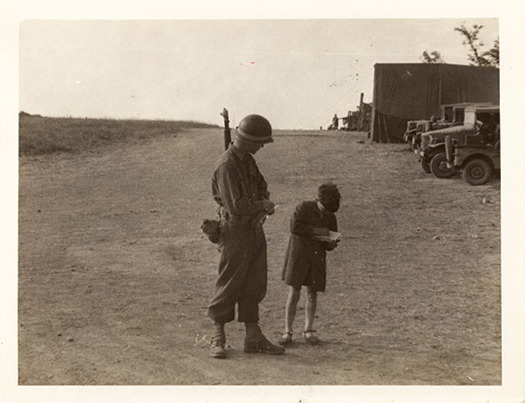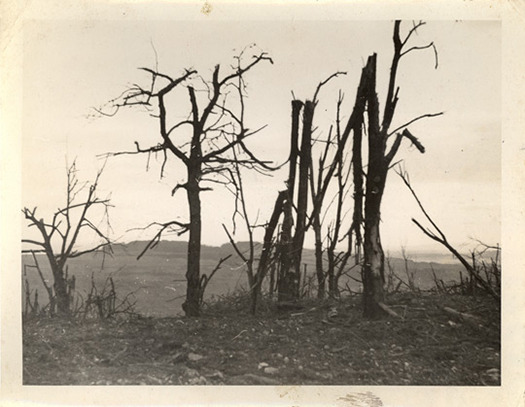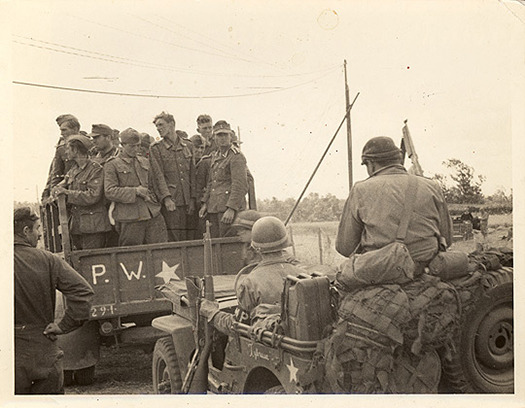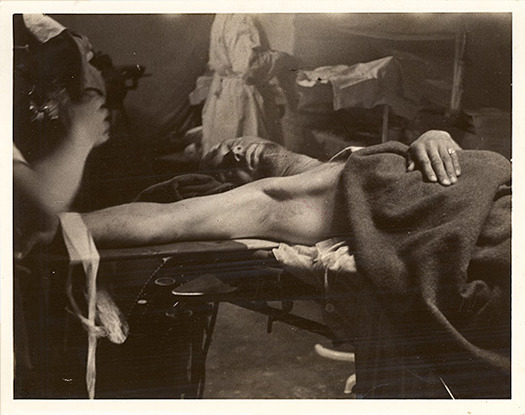
Soldier and boy, Normandy, June 1944
June 6 marks the 70th Anniversary of the D-Day landings. To mark this occasion the editors of the design observer are posting an updated piece, and a slideshow, that first appeared in 2009.
Images of war shape our collective memory. As we mark the 70th anniversary of the D-Day landings the images that most clearly define our visual memory of the invasion are the eleven surviving negatives taken by Robert Capa on the morning of June 6, 1944. These photographs powerfully capture the fear, terror and heroism of war (and they were the inspiration for the first harrowing minutes of Steven Speilberg’s Saving Private Ryan). But there were other photographs taken on the beaches of Normandy that are almost entirely unknown. Rarely seen, they speak to another side of war.

Blasted trees, Normandy, June 1944
A number of years ago, while researching a BBC documentary about World War Two, I paid a visit to Manuel Bromberg at his home in Woodstock, New York. Bromberg had waded ashore and onto Normandy’s Omaha beach in June, 1944. Like the other soldiers he carried an M-1 carbine. But unlike the other men he was packing some specialized equipment: a Leica camera was slung around his neck and a sketchbook was jammed into his back pocket.
Bromberg was one of a select few, a member of the now almost forgotten US War Artist’s Unit. His assignment was, in part, to cover the D-Day invasion. “It was an impossible sight. Bodies were still floating in the water. It was a combination of Dante’s Inferno and the biggest junkyard ever seen” he told me as we walked over to his painting studio, which was on the grounds of his house. Then eighty-seven he was a vigorous man with a gruff demeanor, a rangy gate and leonine hair.
His studio was modest and comfortably cluttered. A number of partly completed paintings hung along a far wall and the worktables were dense with tools and paintbrushes. He took his sketchbook off a shelf and showed me his rough and ready renderings of blasted bunkers, soldiers on the march, evacuations from field medical hospitals. I casually asked about the camera and the photographs. Did they still exist? He gave me a long look, walked over to a corner of the studio and kicked a cardboard box. “Have a look” he said, “they’re all in there.”
Bromberg’s photographs are of a different order from Capa’s. He was not a photojournalist. He was on Omaha beach in the capacity of an artist and his photographs reflect a different set of pictorial priorities. With their informal, almost snapshot quality, their intimacy and their attention to the wreckage of battle they document war’s destructive impact. They also tell the story of a visual artist’s search for material.

Bromberg arrived on Omaha beach after the most brutal fighting had already taken place. Nevertheless he was overwhelmed by what he saw. “Here I was with all this debris of the war and bodies and destroyed homes and destroyed bunkers and destroyed minefields and hedgerows and orchards…it was this enormous visual tapestry. How the hell are you going to handle it?”
His solution was to gather notes, visual notes. Wielding his Leica like a notebook (he was not a trained photographer) Bromberg went about gathering details, photographic images that he envisioned using later in his paintings: the twisted forms of the German defenses, the skeletal outline of blasted trees against a blank sky, the contorted body of a dead German soldier. “I was thinking pictorially. I was thinking not just about the subject matter but also what was evoked.”
His use of the camera gives these images something different from Capa’s adrenaline stoked photos or the more standard framing and subject matter of the official US Signal Corps documentation of the fighting. Bromberg’s photographs are both more consciously aesthetic and more particularly human. Aesthetically, he wasn’t interested in depicting heroics but rather the impact that the forces of war had unleashed on the human body, on the landscape, and on military materiel. He found the crushed and shattered hull of a ship “aesthetically beautiful as a result of violence” which was probably not what the Army had in mind when they sent him on Operation Overlord.
While visiting a makeshift evacuation hospital set up on the bluffs overlooking the beaches, he found himself scanning the dead and dying in search of the telling detail. What he discovered was a soldier stretched out in an almost classically painterly pose. The soldier looks both vulnerable and serene.

Evacuation Hospital, Normandy, June 1944
Bromberg told me that he had felt burdened by the responsibility of his assignment and that he was never able to satisfactorily depict what he had witnessed. The wording of his commission had stated that he was expected to “be more than a mere news gatherer”. It had gone on to state that he should produce work in the tradition of Goya, Gericault, and Delacroix. Understandably, this had made him anxious and depressed. “That’s scary right away, to be told to do like Goya”.
Nevertheless, he found his own way to depict his experience. Never intended to be seen by the public, or to be anything more than working reference sources (which is why they sat in a cardboard box for sixty years) these photographs, with their off-kilter framing and snapshot aesthetic are anti-heroic and quietly powerful.
I returned to visit Bromberg a number of times over the course of the next year or so (his story, sadly, never made it into the film). During that time his awareness of the significance of the photographs grew. “Omaha beach images are set to certain high points. I have photographs of GI’s cutting other GI’s hair on the beach. You don’t see that in Spielberg”.

